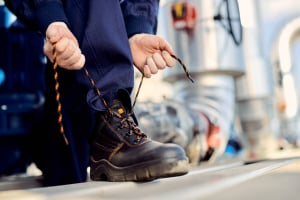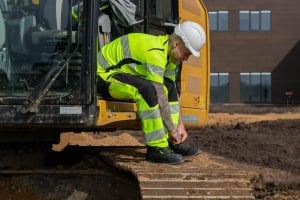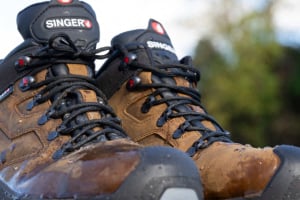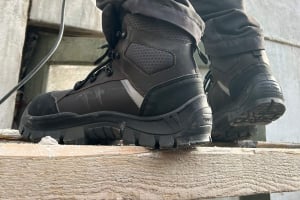
Why are safety shoes mandatory?
When we talk about the term workplace safety, the image that often comes to mind is that of workers wearing hard hats, gloves and safety shoes. Why this array? Why are safety shoes so crucial? In this article, we'll explore this topic in detail and explain why these personal protective equipment (PPE) are so much more than just industrial fashion accessories.
Safety shoes: an obligation for the employer
The introduction of safety shoes into a work environment depends above all on the< strong>obligation of the employerto put in place protective measures for its employees.
According to the standards in force, the employer has the duty to guarantee the safety and health of workers by implementing appropriate measures, avoiding risks and preventing work accidents. work. Safety shoes are therefore an essential element of these protective measures.
Safety shoes are specifically designed to protect workers' feet against multiple risks. They have a puncture-resistant sole, which prevents injuries from stepping on sharp objects. In addition, they also provide protection against the risk of crushing thanks to protective shells located at the toe level.
Safety standards for work shoes
Each pair of safety shoes must meet specific standards to be considered true personal protective equipment. These standards concern the resistance of the materials used, the level of protection offered and wearing comfort.
The EN ISO 20345 standard, for example, defines requirements for general-purpose safety footwear, including criteria such as puncture resistance and comfort.
There are also other specific standards for each type of risk identified in the work environment. For example, for workers exposed to the risk of falling heavy objects, the safety shoe must have a protective shell resistant to an impact of at least 200 joules.
The comfort of safety shoes
It is important to remember that safety shoes, in addition to being PPE essential, must also offer a certain comfort to workers.
An uncomfortable safety shoe can lead to foot pain and even musculoskeletal disorders. Additionally, a worker who does not feel comfortable in their shoes is more likely to be injured because they may be less focused on their work.
To guarantee worker comfort, safety shoes must be adapted to the body shape of each worker and their work environment. They must also be light enough not to hinder movement. Can't stand your safety shoes? Consult our article I can't stand safety shoes: what to do?
Safety shoes: protection against specific risks
Depending on the type of work carried out, safety shoes can protect against specific risks.
For example, for workers operating in an environment where hot materials or flames are present, heat and flame resistant safety shoes are necessary. For those working in wet or aquatic conditions, waterproof, non-slip safety shoes are recommended.
It is therefore essential for each employer to correctly assess the specific risks in their work environment in order to choose the most suitable and effective pair of safety shoes for the protection of their employees.
There you go, you now know why safety shoes are essential in many work sectors. Keep in mind that workplace safety is all about prevention. Choosing the right safety footwear can go a long way to reducing the risk of accidents and ensuring the well-being of all workers.
Legal consequences in the event of non-compliance with safety standards
With regard to the labor code, non-compliance by the employer with its obligations regarding safety at work can have significant legal consequences.
Indeed, the law provides for criminal sanctions for employers who do not put in place the necessary protective measures to guarantee the safety and health of their employees. Among these measures is wearing appropriate safety shoes.
In the event that a workplace accident occurs due to the absence or insufficiency of safety shoes, the employer could be held responsible. He could thus be ordered to pay damages to the victim or his family, and could also be subject to criminal sanctions up to and including prison.
In addition, non-compliance with safety standards, such as the ISO standard for safety footwear, could also result in administrative sanctions. The company could, for example, be fined or have its activity suspended until safety conditions are restored.
It is therefore essential for each employer to scrupulously respect the rules and standards in force regarding safety at work, and in particular those relating to the wearing of safety shoes.
The evolution of safety shoes: towards more technology and innovation
Over time, safety shoes have evolved. Previously perceived as restrictive and uncomfortable equipment, they are now designed to combine comfort, aesthetics and protection.
Safety shoe manufacturers have made many efforts to improve the comfort of shoes. Thus, new lighter and more breathable materials are now used to make these shoes. Furthermore, technological innovations also offer new functionalities. For example, there are safety shoes equipped with a composite anti-perforation sole, lighter and as resistant as steel.
In addition, aesthetics are not left out. Manufacturers now offer work shoes that look exactly like city sneakers. safety sneakers have become a real fashion phenomenon in certain sectors of activity.
Finally, innovation does not stop there. Technology is increasingly integrated into safety footwear. For example, some pairs of shoes are equipped with sensors that detect falls or impacts and automatically alert emergency services in the event of an accident.
Necessary and obligatory
The wearing of safety shoes is one of the essential elements of worker protection in many sectors of activity. This equipment, far from being simple accessories, is a real tool for preventing professional risks. Their use not only protects employees from accidents in the workplace, but also ensures the company's compliance with legal obligations regarding workplace safety.
The evolution of technologies and materials has made it possible to considerably improve the comfort and protection offered by these shoes. Today there is a wide variety of types of safety shoes, suitable for all work environments and all occupational risks.
As an employer, it is therefore essential to choose the right safety shoes based on the specific risks of your work environment, and to ensure that all employees wear them.






